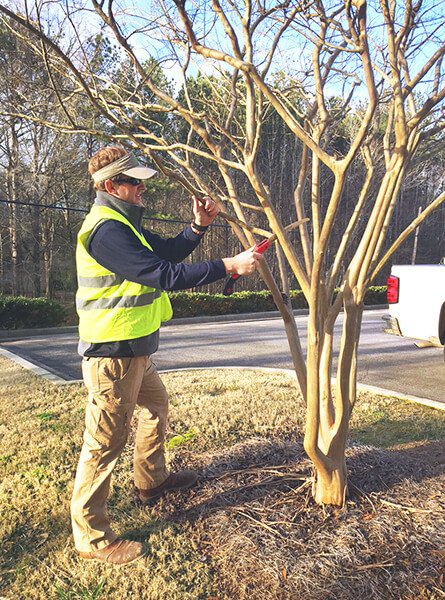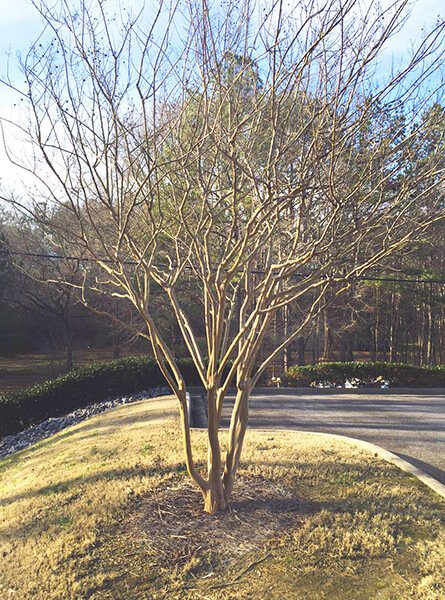Crepe Murder – How to Fix and Care for Crepe Myrtle Trees


You may or may not have heard of the term “crape murder” prior to this, but if you’ve ever driven down the road and noticed trees that have been cut back to an extreme degree, then you’ve seen the unfortunate results of crape murder. The term refers to severely and improperly pruning back the tops of crape myrtles.
A natural growing, correctly pruned crape myrtle should maintain a beautiful shape with arching branches.
One of our Birmingham Account Managers, Chad Galloway, described crape myrtles as “a fantastic landscape plant because they bloom all summer, have a visually interesting branch structure and very few pest issues, and require little to no irrigation.” Crape myrtles, known for their colorful summer blooms and beautiful bark, are the most popular flowering tree in the American south. They are available in a wide array of flower colors including white, red, pink, and lavender. They are also, unfortunately, the most popular plant for being pruned entirely wrong.


The objectives of pruning a crepe myrtle are to maintain its natural form in order to produce strong branches that hold flowers upright and create a canopy in which air can circulate and all branches receive sunlight. Pruning should be performed around this time in late winter (late February–early March) when the tree is in its dormancy because it’s leafless and you can easily see all of the branches. When done correctly, pruning should enhance the tree’s natural shape, not disfigure it.
When pruned incorrectly, the beautiful tree does not develop to the fullest potential. Crape myrtles’ blooms are naturally large and long lasting and while it’s true that crape murder can result in larger blooms, those flowers will grow on thinner, weaker branches that will not be able to support them and droop and may even break. “This becomes an issue when the weight of rain makes the branches begin to sag into walking or driving paths” Chad said. The new profuse growth of branches also prevents air movement and sunlight to reach the inner branches, which can shorten the tree’s life. Aesthetically, the beautiful, delicate appearance of the crape myrtle’s branches, with or without flowers, will be ruined as large knobs appear where the trees have been trimmed incorrectly.
So, why do people continue to do this even though it’s actually hurting the longevity and health of their trees?
Usually, it’s a copycat crime. People see improper pruning all around town so they assume it’s the right thing to do for their own crape myrtles. Unfortunately, it’s not at all. Chad stated, “Don’t participate in crape murder just because your neighbors do.” Most crape myrtles may not even need to be pruned each year. If they do need trimming, and if it’s performed properly, minimum pruning is required. If the tree is pruned wrong, it will require even more pruning as the new growth of smaller branches sprout out all over the tree.
Another reason people seem to believe crape murder is a requirement is due to the tree’s large size interfering with parts of the property. If your tree is too big for its’ location, crape murder will never fix it. The truth is that the tree that was planted was too large to be planted in that area in the first place. Crape myrtle tree sizes can range anywhere from miniature trees starting at 18 inches to large trees reaching 30 feet tall. Tree nurseries will label the plants with this information, and it is just as important as your selections of flower color and bark appearance. As a rule of thumb, don’t cut to see over them, cut to see through them. Chad said, “As with all landscape designs and installations, the key is putting the right plant in the right place.” Large trees that are causing issues with the property will most likely need to be removed and replaced with a more suitably sized tree. Fortunately, even large crepe myrtles can be transplanted with success, and a landscape professional will be able to help you plant a replacement and move the large tree to a better-suited location.
What do you need to do if you’ve already committed crape murder? It’s never too late to stop pruning incorrectly. Renewal pruning, or cutting the tree’s base down to the ground, will allow the tree to have a fresh start, and it will rapidly grow back healthy and strong in two-three years.
Now that you know what not to do, here is the right way to prune a crape myrtle.
Once per year in the late winter, check for the following items:
- The tree’s canopy needs to be raised for visual appeal and/or height clearance. Raising the canopy, or cutting branches that curve out too wide or hang too low gives the tree a slimmer appearance at the base that flares up at the top and allows air to better circulate. Try to remove unwanted branches before they get thicker than a pencil.
- If the tree has branches that are dead, diseased, growing inward, or crossing other branches, remove them. Be sure to remove the weaker of any two crossing branches.
- Unwanted seedheads can be cut off if desired for appearance, but it is unnecessary and will not hinder next year’s blooms.
That’s it! Stand back and look at your tree. If there are no dead or poorly placed thin branches sprouting out of the tree’s natural shape, you’re done. Proper pruning of crape myrtles should not be a time-consuming process and involves little, if any, cutting of thick branches or the main trunk. A well-pruned crape myrtle should not look like it has been “pruned” at all. “When pruned properly and allowed to grow to it’s full, natural height, a crape myrtle can be what brings a passerby’s eyes in the direction of your property,” Chad stated.
Before and After Proper Pruning:

Help us spread the word about crape murder and have a landscape professional come out to your property to help you properly plant or prune crape myrtles. Our team is happy to help answer any more questions you have about pruning crape myrtles or any other landscape questions. Contact us at the branch closest to you!






















